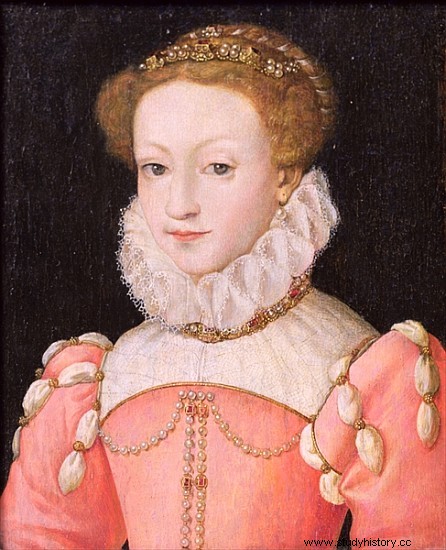Mary Stuart or Mary I of Scotland (1542-1587) is a sovereign of Scotland. Imprisoned by her cousin, Queen Elizabeth I re of England, she was convicted of high treason and executed.
On the throne of Scotland at six days
 Daughter of Marie de Guise and James V of Scotland, born December 7 or 8, 1542, Marie Stuart is the third child in the family, but his two older brothers died shortly after birth. On December 13, James V died of cholera, and his death effectively placed Mary Stuart on the throne of Scotland, six days old.
Daughter of Marie de Guise and James V of Scotland, born December 7 or 8, 1542, Marie Stuart is the third child in the family, but his two older brothers died shortly after birth. On December 13, James V died of cholera, and his death effectively placed Mary Stuart on the throne of Scotland, six days old.
James Hamilton, Earl of Arran, the next heir to the crown, was appointed regent in January 1543. After an attempted broken alliance with England and Henry VIII, on September 9, at ten months old, Mary was crowned by Cardinal David Beaton, head of the Catholic Church of Scotland and opponent of Henry VIII.
Women's education
An intermittent war then broke out between England and Scotland, which relaunched its diplomatic policy towards France. As a result, Marie Stuart will experience a French and Catholic influence rather than English and Protestant. In 1548, Marie was again promised in marriage, to the Dauphin of France this time; in August, as a child not yet six years old, she embarked for Roscoff without her mother to be educated at the court of France.
There, Marie learns what makes life at court at the time:horse riding, falconry, music, dance, rhetoric, Latin, literature, history, geography, languages... She also learns poetry with Pierre de Ronsard. In May 1555, she gave a speech in Latin before the Court in which she asserted that an education in letters and the human sciences was adequate for a woman.
Queen of Scotland
On April 24, 1558, the wedding ceremony of Marie Stuart and François, Dauphin of France, took place in Paris. In July 1559, the king of France Henri II dies and Marie Stuart finds herself queen of France. Her husband being too weak in health to govern, he entrusted power to his uncles from Guise (from the family of Marie) on the advice of his wife, which his mother Catherine de Medici resented. Francis II died in 1560 and Mary Stuart retired to mourn.
In 1561, Mary Stuart returned to a Scotland torn by religious wars and court intrigues and, as a Catholic, she was viewed with suspicion by part of the population. Tolerant of Protestants, it also alienates Catholic leaders. In 1565, Mary married without notice Henry Stuart, Lord Darnley, a grand-nephew of King Henry VIII, with whom she had a son. The marriage quickly turns into a disaster; Marie takes a lover, Lord Bothwell, and when Darnley is found strangled to death, Marie Stuart's reputation takes a hit. Arrested by a confederation of Scottish nobles, Mary was imprisoned in Loch Leven Castle in June 1567. On July 24, she abdicated the throne of Scotland in favor of her one-year-old son James.
Prisoner of Elizabeth I
On May 2, 1568, Mary Stuart escaped and raised an army, but she was defeated at the Battle of Langside on May 13, she fled to England, where she was imprisoned by Elizabeth in Carlisle on May 19.
An investigation then opens, in particular on the murder of Darnley; Considering Mary's claims to the throne as a plot, Elizabeth puts her under house arrest for eighteen years. But the charge becoming too heavy, Elizabeth's advisers weave a plot against Mary Stuart, posing to her as conspirators who can help her overthrow Elizabeth. Mary Stuart falls into the trap; letters sent to her supporters (possibly encrypted) are intercepted and she is sentenced to death and then executed on February 8, 1587.
On the day of her execution, Mary Stuart chooses to wear a red dress, proclaiming herself a Catholic martyr. The execution marks the spirits by its atrocious side:the executioner, drunk, must try it several times before putting an end to Marie's ordeal.
